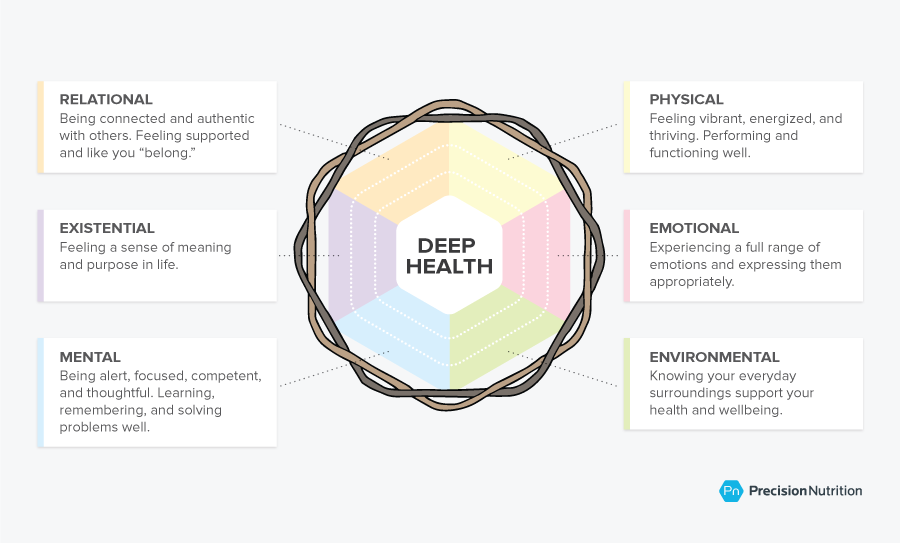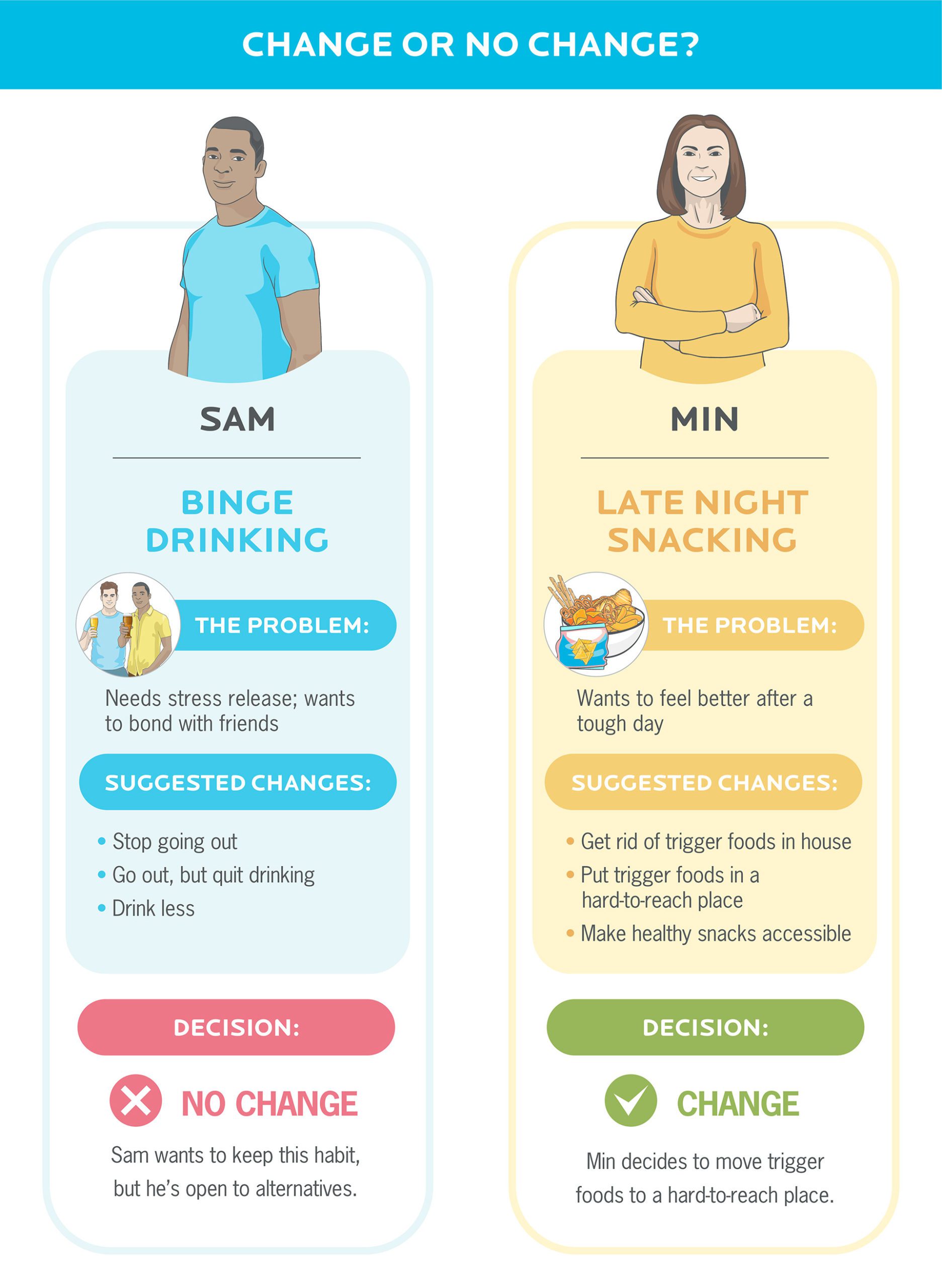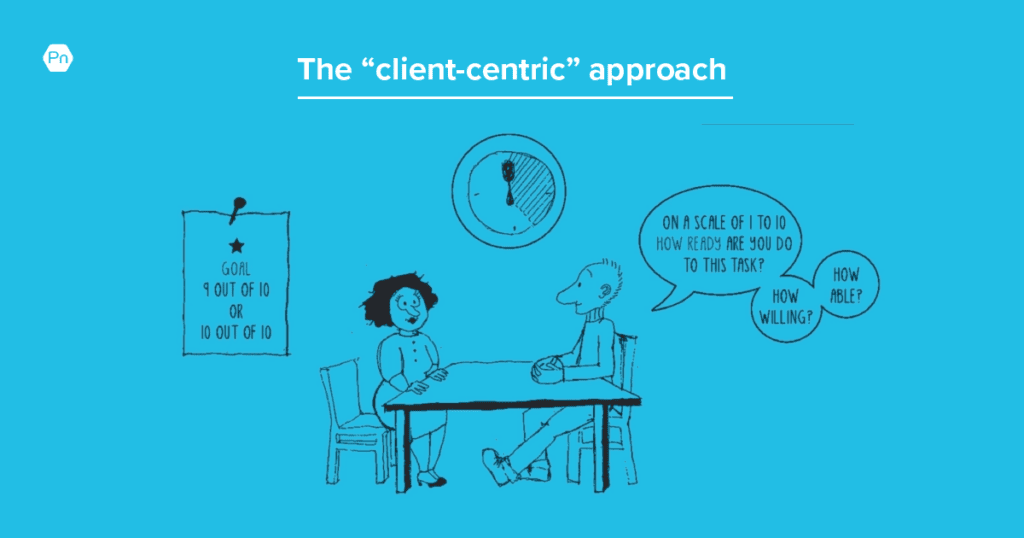People have their reasons.
For overeating. Skipping exercise. Ignoring your advice.
And if you want to help clients overcome these types of self-sabotaging behaviors, you need to understand what those reasons are.
This is a universal law of nutrition coaching.
It’s also a powerful concept that can transform you from “frustrated coach” to “client whisperer.”
How so? Let’s explore.
Ever have a client say they desperately want to change—but also seem mired in self-sabotage?
Maybe they’re:
- having four glasses of wine every night,
- cancelling workout sessions last minute, or
- burying a pint of ice cream right before bed.
Clearly, these behaviors are in direct conflict with their goals. It almost seems like they’re doing it on purpose just to make you feel like a failure as their coach, right?
Not so fast.
It could be their way of solving an even bigger problem than the “muffin top” they keep complaining about.
Maybe a problem you haven’t even considered.
Your client might be drinking four glasses of wine because it helps them temporarily forget that their job sucks.
Or cancelling appointments because of trauma that makes them feel deeply uncomfortable in a gym.
Or pounding Ben and Jerry’s because it soothes their anxiety.
So don’t assume they’re ignoring your advice. Instead, focus on connecting the dots.
When you understand there’s a deeper reason behind every bad habit, you’ll be able to:
- have more empathy for your clients
- feel less bothered when clients don’t do what they’ve agreed to do, and
- use more effective strategies to help people change their behavior.
Those three things? They’re a formula for making you an awesome coach.
In this article, we’ll give you a step-by-step process for uncovering the real obstacles that are stalling your clients’ progress.
But even better, we’ll show you how to create solutions that actually work.
(For even more nutrition, health, and coaching solutions that actually work, sign up for our FREE weekly newsletter, The Smartest Coach in the Room.)
++++
All human behavior is an attempt to cope with or solve a problem.
Sit with that for a moment.
When we give presentations to coaches, this single piece of information visibly blows their minds.
Sometimes, it’s straightforward:
When you’re hungry (the problem), you eat (the behavior).
But often, it’s more complicated. Because usually, you see the behavior, but you don’t know about the problem.
For instance…
… when you snap at your partner for asking a totally harmless question about tonight’s dinner (the behavior), it’s usually not because of the question your spouse asked. It’s likely due to something else, like that irritating email from your coworker (the problem).
… when your hyperactive kid acts out (the behavior), it’s because she’s trying to release pent-up energy (the problem).
… and when your mom drops in unannounced to do your laundry long after you’ve reached adulthood (the behavior), it’s probably not because she’s dying to fold your underpants. She probably wants to feel needed, and currently, she’s not (the problem).
Similarly, unwanted eating behaviors are frequently related to a deeper problem that doesn’t start with the food.
This presents a challenge, since many nutrition coaches focus exclusively on food: meal plans, macros, organic vs. conventional, supplements, and so on. Which, intuitively, makes sense.
You want to make sure your client is getting the nutrients they need. So the two of you agree that they’re going to try eating more veggies.
But your client’s food log shows a whole lot of ice cream… and not much else. Last time you checked, ice cream wasn’t a veggie. (It feels like someone should invent that… )
So what happened? Why didn’t your client do what they agreed to try? Probably because…
Food isn’t the problem.
It almost never is.
This idea is one of the foundations of Precision Nutrition’s coaching method, which we’ve validated with over 150,000 clients and in three peer-reviewed research studies.
To illustrate how this coaching principle works in practice, we’re going to discuss two case studies.
Meet Sam and Min.

Sam is a 24-year-old medical student with a super hectic schedule. When he’s not in class or in the lab doing research, he’s studying.
He also comes from a culture where family time is extremely important. So he spends a lot of his off-hours with his parents and siblings.
Sam wants to get swole, but regularly binge drinks with his med school buddies (who also happen to be his roommates). That’s causing all sorts of problems with his nutrition, workouts, and recovery.
Min is a 56-year-old mother of two teenagers. She’s also a caregiver to her aging parents. Oh, and she has a full-time office job.
Slim until her mid-40s, Min’s now struggling to get rid of the spare tire around her midsection.
Min sticks to mostly whole, nutrient-dense foods during the day. But she struggles with nighttime snacking. The late-night chips, cookies, and dinner leftovers are making it tough to shed fat.
It might be tempting to tell Min to just stop snacking at night. Or tell Sam to quit the excess drinking.
After all, how hard can it be to just… stop?
But you probably know:
Clients don’t always do what they say they’ll do.
Why? In many cases, if they did what you asked, they’d be left with a problem—stress, feelings of unworthiness, desire to fit in socially—without a solution.
So what’s the best way to approach situations like these? Let’s find out.
5 steps to addressing the problem behind the behavior.
Step 1: Learn more about the behavior.
Let’s take a look at Min’s snacking.
Your task: Explore with Min exactly, specifically, precisely, and concretely the behaviors she’s describing.
You might ask questions like:
- “In the hours before you end up snacking, what are you usually doing?”
- “Immediately before you start snacking, what are you thinking about?”
- “While you’re snacking, how do you feel physically? Is anyone with you?”
- “After you’re done, how do you feel emotionally?
The answers to these questions will help you better understand what’s going on with Min. But they’ll also help HER understand it.
In fact, the more you probe for details, the more likely it is that Min will identify what’s behind her late-night snacking and develop solutions on her own.
You can use our Behavior Awareness worksheet to facilitate this process with any client. (It would work well for Sam’s binge drinking issue, too.)
Step 2: Figure out the problem.
Once you know the behavior—thanks to step 1—it’s time to identify the problem. This is the fun part.
Sometimes, clients can easily identify their problem.
After completely the Behavior Awareness worksheet, Min might come right out and say:
“You know, it seems like anytime I have a tough day and feel underappreciated, I start snacking. Between work, taking care of my kids and my parents, and trying to take care of myself, I’m just under a lot of pressure. My mom has cancer, and we’re all having a tough time with it. Plus, she keeps giving me a hard time about why I’ve never made anything of my life.”
Seriously, figuring out the problem (or in this case, problems) is occasionally that easy. And when you hear about all the things going on in Min’s life, her “solution” makes total sense as a way to get immediate (but short-lived) relief.
Other times, clients have no idea what the real problem is.
So, you get to do a little detective work.
With a mindset of compassionate curiosity, think of this as a puzzle that you and your client will solve together.
One way to do that is by asking what we call “two crazy questions.”
It goes something like this…
“Sam, I’m going to ask you two crazy questions, and I know this is going to sound really weird, but just humor me…”
Question 1: “What’s GOOD about drinking so much on the weekends? In other words, what purpose does it serve in your life? How does it help you?”
Question 2: “What would be BAD about changing? What would you lose or give up if you stopped drinking so much when you go out?”
Sam might reveal that drinking with his friends helps him destress from a long week of academic, work, and family commitments.
He knows drinking less would make it easier for him to eat better and get to the gym regularly.
But Sam also worries that he and his med school buddies won’t have fun if he’s not there with a beer in his hand. Valid or not, that fear is very real for Sam.
So the problem is two-fold:
Sam feels (understandably) stressed because of his demanding schedule, and he also sees himself as responsible for his friend’s ability to have fun together.
What if my client’s problem is out of scope?
Depending on what your client’s dealing with, you may need to refer out another professional.
Let’s say they were emotionally or sexually abused, and they’re dealing with the aftershocks of that.
These issues are way outside your scope. But if you have a good referral network, you can get your client the support they really need.
But that doesn’t mean you should drop them as a client. Rather, your client merely adds a new player with a different skillset to their support team.
Provide accountability, and help your client work on the fundamental skills they’re ready, willing, and able to tackle—while they’re also getting help with their deeper-seated challenges and concerns from a qualified professional.
Often, when someone starts improving their eating, fitness, sleep, or stress-relief habits, their bigger, underlying challenge becomes easier to manage. Because it’s no longer being compounded by feeling bad about their health habits.
By the way, we also suggest having your own referral network (for YOU). Clients’ “stuff” may bring up your personal “stuff,” and you’ll benefit from having your own “stuff support system.”
Step 3: Get on your client’s team.
Here’s where you get to be your client’s biggest fan. You’ll solidify your coaching relationship in the process.
Identify what’s good about your client and their unwanted behavior.
You want to find the silver lining, even if it’s hard.
Turn their problems into evidence of their strengths and resilience.
Here’s how you might do that with Sam:
“Sam, it sounds like you’re the social glue that’s holding your group together. Everyone’s so stressed out with med school and stuff, and you’re the party guy who tries to liven up everyone’s mood. That’s a real testament to how much you care about your friendships. It’s honestly impressive how you make time to prioritize them.”
Here, it’s particularly important to be aware of how your own experiences and biases may cloud your perspective.
For instance, if you’ve always been a fit athlete and you’re coaching someone like Min, you’ll need to set aside the idea that staying fit and avoiding trigger foods is “simple.”
Emphasize the positives of not changing, as well as what’s admirable about your client:
“Min, it’s amazing how you’re able to juggle two teenagers, a full-time job, and your parents who, if I’m being honest, sound a little bit challenging to deal with. I can’t even imagine! Gosh, I can’t even call my mom for 15 minutes, and here you are doing it constantly. That says so much about your commitment to family. I really admire that.”
This step might not seem that important. But it assures your client you’re not judging them. It also validates their feelings, making them feel heard and respected. Often, it also gets them to start viewing themselves (and their actions) through a different, more positive lens.
Bring on the warm fuzzy feelings. Because your client’s going to need them to make an important decision, which brings us to step 4.
Step 4: Let your client decide whether to change.
Most people resist change.
No one wants to give up doing stuff they like.
But here’s the funny thing about resistance: Giving someone permission to NOT change can actually make them realize that they DO want to change.
So ask your client:
“Given all of this, do you want to change? Not changing is perfectly okay.”
This, of course, can require a vomit-inspiring leap of faith. You have to genuinely be okay with them not changing that behavior.
In fact, there are times when not changing their behavior could be healthier than the alternative.
A client’s 12-hour-a-week exercise habit might seem extreme to you. But it may be helping them cope with their failing marriage.
If you take away (or greatly reduce) the exercise, they might start coping in a way that’s more destructive.
Maybe your client doesn’t want to eat any veggies, like, ever. Think: the carnivore diet.
They understand the health risks. And they’ve established they’re doing it because food is the one thing in their life they can control. So they’re not willing to change.
You have to accept that. (Although you don’t necessarily have to keep working with them.)
Depending on your client’s change vs. no change answer, the next step can go two different ways.
Step 5: Develop strategies together.
Let’s walk through two scenarios. In one, your client 100% embraces change. In the other? Not so much.
Client wants to change: Brainstorm what that might look like.
Min decides she does want to change. She sees what the nighttime snacking is doing for her, but she’s ready to try something different.
Importantly, you don’t want to just throw solutions at her. Instead, get her talking about where she sees opportunity for change.
You might try questions like:
- “Put your coach hat on. If you were in my position, what might you suggest you do?”
- “If you could do anything to stop snacking at night—even if that seems crazy—what would you do? Let’s just brainstorm and not worry about reality for the next few minutes.”
Work together to select one new action, making sure it feels super realistic given the confines of Min’s life—even if it’s challenging.
Maybe, for example, Min starts by reorganizing her kitchen to help her avoid nighttime snacking. She stores trigger foods out in the garage, including the dinner leftovers, which now go straight to the garage mini-fridge. That way, her kids can still enjoy them if they want, but they’re out of sight for Min.
A key step: Ask Min whether she’s ready, willing, and able to incorporate this new habit into her routine.
If she rates a proposed change at less than an 8 on a scale of 1 to 10, find out what it would take to get her fully on board. Often, it’s reducing the intensity of the habit so it feels more manageable. (Our Ready, Willing, and Able worksheet will come in handy here.)
Client doesn’t want to change: Try changing something else.
Sam doesn’t want to change his drinking habits. He understands the tradeoffs, but he’s just not ready to do things differently.
That’s okay.
Say something like:
“Okay, so it sounds like you want to feel fitter and less stressed. But right now, quitting drinking with your friends doesn’t feel like the right solution for you, which makes sense. What else can we do to move a tiny bit towards your goal?”
Maybe Sam would be willing to limit himself to three drinks per social outing, down from his usual five or six.
Or, he might not want to change his drinking habits at all. No big deal.
Rather than see this as a failure, think of it as an opportunity.
Sometimes, you have to look further upstream to solve the problem.
In other words, maybe Sam won’t be able to stop binge drinking until he changes something else.
For example, take a look at the “deep health” graphic below.
Suppose you’re lonely and feel disconnected from others (see: relational health). You might eat or drink more to comfort yourself, which negatively affects your physical health. And that might lead to feelings of anxiety or anger, which challenges your emotional health.

All the areas of deep health are interconnected. By working in one area, you automatically address the others. (Learn more about deep health.)
So in Sam’s case, you might work together to come up with stress-reducing strategies like:
- taking a daily walk at lunch (physical health)
- incorporating a 5-minute body scan most days (mental health)
- developing a self-compassion practice (emotional health)
Although these actions may at first seem like they have nothing to do with nutrition, they often have everything to do with nutrition.
Implementing one (and eventually more) of these habits could lighten Sam’s stress load. That would make it easier, over time, for him to prioritize working out and healthy eating, getting closer to the swole body of his dreams.
Wherever your client ultimately decides to focus, it’s time to step back and see what happens.
Along the way, monitor how things are going, and assess whether they’re:
- struggling and need to scale back
- doing pretty well, but still need to work on the current habit, or
- mastering the current habit and ready to add another.

This lesson won’t just change your coaching. It’ll change your whole life.
Understanding the motivation behind unwanted behaviors sets you up to be a pretty dang amazing coach.
And the more you explore the problems behind behaviors, the more you’ll see how this concept sheds light on virtually every sticky situation in life.
Yes, it applies to your client who’s always late. But also the cranky guy overreacting about the barista getting his order wrong. And your friend who suddenly withdraws from your social circle.
So whether you’re in a position to help them or not, understand that much of what you experience with others isn’t personal.
After all, people have their reasons.
If you’re a coach, or you want to be…
You can help people build sustainable nutrition and lifestyle habits that will significantly improve their physical and mental health—while you make a great living doing what you love. We'll show you how.
If you’d like to learn more, consider the PN Level 1 Nutrition Coaching Certification.




Share